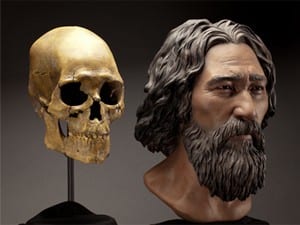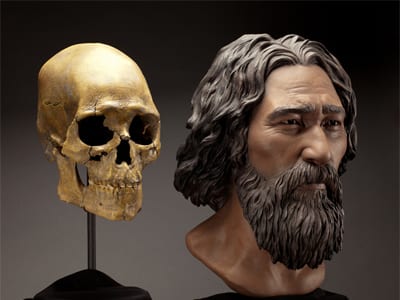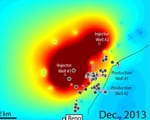
KERA News reporter Justin Martin interviewed SMU archaeolologist David Meltzer from the SMU Department of Anthropology in Dedman College of Humanities and Sciences about the controversial 8,500-year-old skeleton called Kennewick Man.
Meltzer was part of a new study, “The Ancestry and Affiliations of Kennewick Man” in the journal Nature, that analyzed Kennewick Man’s genome sequence and found that Kennewick Man is more closely related to modern Native Americans than to any other population worldwide.
The study was led by the Centre for GeoGenetics at the University of Copenhagen and was published online June 18, 2015 in Nature.
Meltzer researches the origins, antiquity, and adaptations of the first Americans – Paleoindians – who colonized the North American continent at the end of the Ice Age. He focuses on how these hunter-gatherers met the challenges of moving across and adapting to the vast, ecologically diverse landscape of Late Glacial North America during a time of significant climate change.
Meltzer’s archaeology and history research has been supported by grants from the National Geographic Society, the National Science Foundation, The Potts and Sibley Foundation and the Smithsonian Institution. In 1996, he received a research endowment from Joseph and Ruth Cramer to establish the Quest Archaeological Research Program at SMU, which will support in perpetuity research on the earliest occupants of North America.
Meltzer is a member of the National Academy of Sciences and the Henderson-Morrison Professor of Prehistory in SMU’s Dedman College.
The KERA interview aired July 14, 2015.
Listen to the interview, “DNA From Kennewick Man Shows He Was Native American, Says Study With SMU Ties.”
EXCERPT:
By Justin Martin
KERA NewsNearly two decades after an ancient skeleton was discovered in Kennewick, Washington, scientists finally have a better idea about its hotly-debated origins. SMU anthropologist David Meltzer co-authored a recent study into what’s been dubbed the Kennewick Man.
Interview Highlights: David Meltzer …
… on the age of the ‘Kennewick Man’: “Kennewick man is about 8,500 years old and that’s based on radiocarbon dating of the actual skeleton, and his origins have been quite controversial. The question was: Was he related to modern day Native Americans or does he represent an earlier population that came into the new world, which was in turn subsequently replaced by modern day Native Americans? What the DNA evidence shows is he was one of them, he was a Native American.”
… on why it took so long to figure out his origins: “In the late 90s, DNA efforts were made to recover something, but in those days the techniques and technologies was so very primitive. You needed a decade or more of ancient DNA work to bring it up to speed to make it possible to reconstruct Kennewick’s DNA.”
… on how the research turned into a lawsuit: “The Army Corps of Engineers, at the request of the Native American tribes, sought to reinter Kennewick into the ground immediately. The tribes had made the argument that Kennewick was one of their ancestors and that therefore his remains fell under what is referred to as NAGPRA or the ‘Native Americans Graves Protection and Repatriation Act.’ A number of individuals sued in turn claiming that he wasn’t a Native American and therefore NAGPRA does not apply. The lawsuit started in the fall of 1996, it was finally resolved in 2004. An appeals court said he’s not a Native American [and to go] ahead and do a study. Here’s the ironic part — as a part of that study, a bit of the bone was provided to my colleague … who analyzed the DNA, which demonstrates in fact that he is a Native American. The lawsuit to basically show that he wasn’t turned out to show that in the end, he was.”
Listen to the interview, “DNA From Kennewick Man Shows He Was Native American, Says Study With SMU Ties.”
Follow SMUResearch.com on twitter at @smuresearch.
SMU is a nationally ranked private university in Dallas founded 100 years ago. Today, SMU enrolls nearly 11,000 students who benefit from the academic opportunities and international reach of seven degree-granting schools. For more information see www.smu.edu.
SMU has an uplink facility located on campus for live TV, radio, or online interviews. To speak with an SMU expert or book an SMU guest in the studio, call SMU News & Communications at 214-768-7650.


 At peak fertility, women who desire to maintain body attractiveness report they eat less
At peak fertility, women who desire to maintain body attractiveness report they eat less SMU seismology team to cooperate with state, federal scientists in study of May 7 Venus, Texas earthquake
SMU seismology team to cooperate with state, federal scientists in study of May 7 Venus, Texas earthquake 1st proton collisions at the world’s largest science experiment expected to start the first or second week of June
1st proton collisions at the world’s largest science experiment expected to start the first or second week of June Most likely cause of 2013-14 earthquakes: Combination of gas field fluid injection, removal
Most likely cause of 2013-14 earthquakes: Combination of gas field fluid injection, removal Physicists tune Large Hadron Collider to find “sweet spot” in high-energy proton smasher
Physicists tune Large Hadron Collider to find “sweet spot” in high-energy proton smasher SMU geothermal scientist Maria Richards to guide global energy organization
SMU geothermal scientist Maria Richards to guide global energy organization